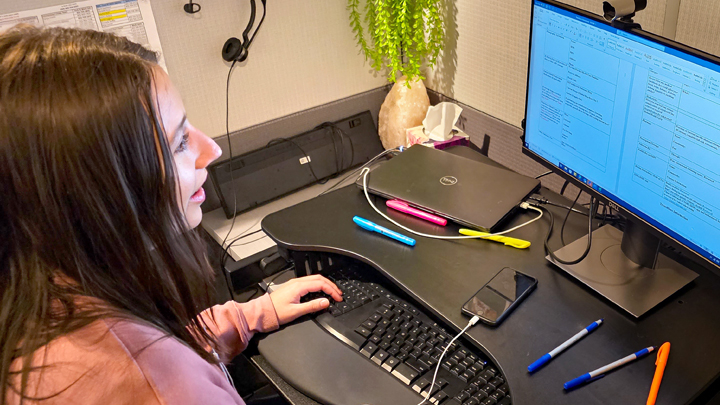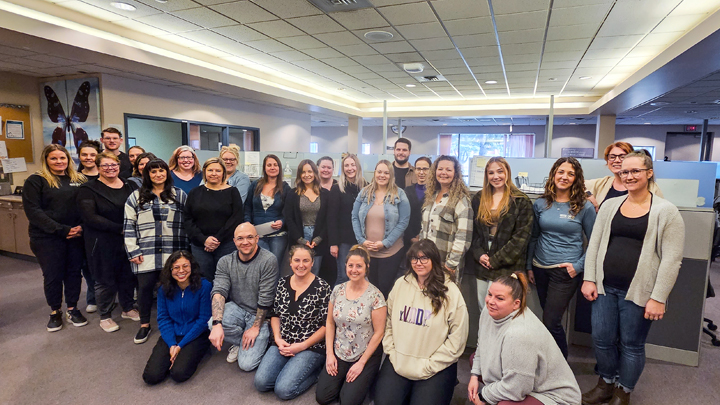
November 16, 2023

Registered Psychiatric Nurse Maisy Osadczuk does a mock intake-assessment call for the Virtual Opioid Dependency Program. Photo by Heather Kipling.

The Virtual Opioid Dependency Program team helps Albertans struggling with opioid use concerns to begin safe and effective treatment to support their recovery. Photo by Heather Kipling.
Story by Katie McLaughlin | Photos by Heather Kipling
When someone is struggling with opioid use concerns and is ready to seek safe and effective treatment to support their recovery, urgent access to support is everything. That’s where Alberta Health Services’ (AHS) Virtual Opioid Dependency Program (VODP) can help.
“When someone is reaching out for help with an opioid use concern, our priority is getting them the support they need as quickly as possible,” said Megan Mielnik, ongoing care manager with the VODP. “Using virtual technology has allowed us to immediately connect with Albertans and get them the help they need, when they need it.”
The VODP uses virtual tools like Zoom to increase access to opioid agonist therapy, which involves taking medications that treat opioid addiction by reducing cravings and managing withdrawal symptoms. The use of virtual technology has enabled the program to expand its services to all Albertans in need of support—in fact, about 95 per cent of their services are provided through virtual tools.
In its first year, the VODP supported clients in 43 communities through telehealth technology. Now, thanks to the addition of other virtual technology like Zoom, VODP has supported clients from more than 370 communities throughout Alberta. Since it began in 2017, there have been more than 18,000 admissions to the program.
“VODP is a great example of how virtual technology can help expand the reach of a program, allowing it to become accessible for even more people who need it,” says Richard Tang, a clinical facilitator with AHS’ Virtual Health team. “Now, Albertans anywhere in the province can access the program and get the help they need, quickly.”
Virtual technology has significantly reduced wait times to initiate treatment. In fact, current wait times for initial contact with AHS’ Opioid Dependency Program (ODP) are less than one hour, meaning Albertans seeking help with opioid use concerns can quickly access same-day treatment.
“The opioid epidemic isn’t just happening in urban centres where someone can come to one of our community based ODP programs to be assessed in person,” added Mielnik. “Virtual technology has allowed us to provide support to Albertans when and where they need it, regardless of where they are in the province. Timely access to support is critical for someone reaching out for help with opioid use concerns.”
Referrals to the program come from many health professionals, including doctors, pharmacies, addiction counsellors and through self-referrals. It starts with a phone call.
“Once someone decides to make that call, our same day start team does an assessment over the phone,” says Ariel Raspa, a registered nurse who does admission assessments with the VODP. “An on-call physician then reaches out to the individual. Depending on what medication they’re looking for, that call is either over the phone or done through Zoom.”
Once the assessment is completed by an addiction medicine physician, a prescription is sent through to the person’s preferred community pharmacy. They will often start the treatment the same day if the pharmacy has the medication in stock. The VODP admission manager and individual receiving treatment have daily contact until they are stabilized on their treatment medication. Then, they have the option of being referred to VODP to continue their treatment, or they can work with an AHS community-based ODP across the province.
The VODP team is available for assessment and initiation from 8 a.m. to 8 p.m., seven days a week. Physicians can access the on-call physician for treatment consultations via RAAPID.
VODP isn’t just available to adults—it also supports youth and young adults. In fact, the Government of Alberta invested $4.5 million over three years last November to expand the VODP to further support youth and young adults through a specialized youth team, in partnership with Alberta Children and Family Services.
“We’ve always served youth that came to the program through our regular VODP,” said Mielnik. “However, youth struggling with opioid use disorder is very complex, especially if that youth is under the care of Children and Family Services. We recognized the need to have a specialized youth-focused team to address those complexities and streamline access to care which is why we partnered with Children and Family Services.”
The specialized team offers rapid assessment, youth programming focused on recovery, peer supports, education and training, and more. When participants turn 18-years-old, they are transitioned to the adult VODP team, meaning there is no gap in service.
Since the youth VODP started in February 2023, an estimated 63 youth and young adults from across Alberta have been supported by the team.
VODP also works with Alberta Correctional Services, the RCMP and works closely with other AHS ODP clinics licensed by the Mental Health Services Protection Act to provide narcotic transition services in the province.
AHS is celebrating Digital Health Week, Nov. 13-19. Virtual technology and the support of AHS’ Virtual Health team are integral to the ongoing success of the VODP. As well, Nov. 19-25, is National Addictions Awareness Week, and the theme is Inspiration, Innovation and Inclusion.